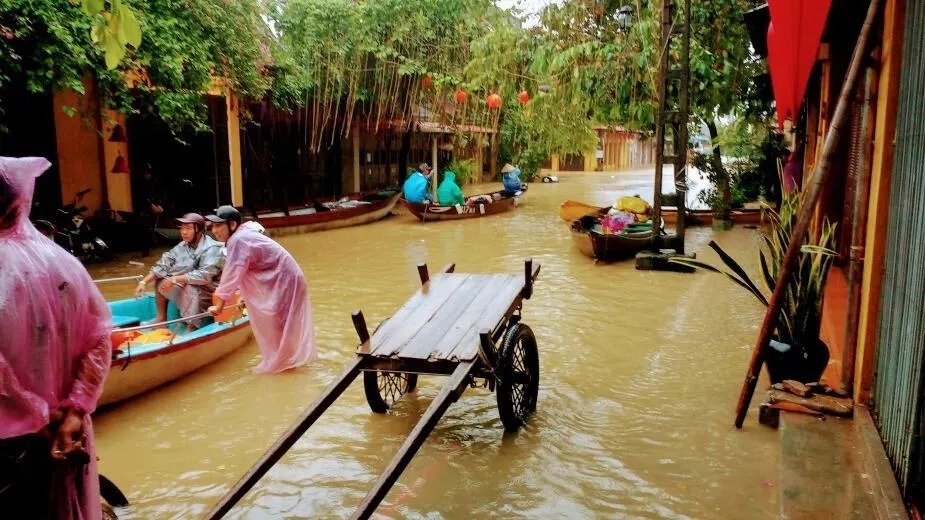Our second “H” city heading north is Hoi An. This smaller city is approximately 24 square miles and is home to only around 120,000 people. It is beautifully situated on the central coast of Vietnam and is known for being a well preserved and historically ancient town with several canals throughout. The city used to be a port and its melting pot history can be seen in the architecture with a mixture of styles and eras from French Colonial buildings, Chinese shop houses, Vietnamese tube houses (tall densely packed homes) and a Japanese covered bridge with pagoda.
Weather

The weather in Hoi An is not always perfect, but if you enjoy weather in the eighties almost year round, it is as close to perfect as a climate can get. Six months out of the year (April through October) are warm and dry with the other half (November through March) having somewhat cooler temperatures and more precipitation1161.
Although the population of Hoi An is smaller, so also is the city itself. It is one of those beautiful places travelers visit during the warmer months of the year. Getting around town is easy in that from one point of the city to the other, there isn’t a lot of mileage to cover.
Transportation

However, because it is so small, there also can be an issue with overcrowding on the streets during the busy seasons with a higher percentage of traffic accidents here than in the most other cities.
Cyclos (three-wheeled bicycle taxis) are quite common here as are motorbikes. If you choose to own transportation, the motorbike is the suggested way to go. However, one very important consideration in Hoi An is that three times each day the streets are completely closed to all motorized vehicles including motorbikes. Be sure to take that obstacle into account in your decision whether or not to own a vehicle of any kind if you choose to live in Hoi An.
The city does have an airport, but is somewhat limited in the number of flights going in and out every day. Most people coming into the city first fly into Da Nang and then make their way to Hoi An from there.
You will also find that the city does not have its own train station and again, the closest is in Da Nang. Hoi An isn’t necessarily closed off travel wise, but just know you will likely need to go to Da Nang for a more robust travel hub.
Food
Hoi An has a signature dish “Cao Lau” that consists of chicken rice, quang noodles and white rose. Locals and tourists alike rave about this dish and it can be found in any Vietnamese restaurant as well as many of the street vendor carts. While there are not quite as many food varieties in Hoi An, as there may be in other parts of Vietnam, you can find a couple of international food options if Vietnamese food is not your first choice. For a smaller sized city it does have a lot of eateries.
Nightlife and Shopping

The nightlife in Hoi An is comprised of trendy cafes, bars, bistros, live music venues and artistic lounges. The majority of these will be found in the Riverside or Ancient Town areas.
After the sun sets the streets of Hoi An are transformed into a vibrant and entertaining display with traditional lanterns, performances from folk dance to singing and tons of lit candles that float down the Thu Bon River. A lot of cities in Vietnam the locals are known for turning in early, but in Hoi An, the nightlife places are bustling and typically remain open until three in the morning.
The locals in Hoi An are described as fun-loving. You will be in great company and have late night access to what is arguably known as the cheapest beer in all the world. To top it off, there are happy hour promotions which make the cost of your spirits even cheaper all the while being entertained by DJs playing a variety of genres.
The town may be small, but there are more than a dozen different places to check out once the stars come out at night.
Shopping in Hoi An in general does not disappoint. From antiques to fresh fruit and flower markets, there is something for everything you will need for your stay in Hoi An.
Where grocers are concerned, Hoi An has four (4) for you to choose from with two toward the center of the city and two more closer to the outskirts. This makes it easy for you to get to one no matter what part of the city you may decide to stay.
For a smaller town, there isn’t the feeling that there is anything missing. With grocers, tailors, florists and liquor stores, all your basic needs should be covered in Hoi An.
Like many of the cities in Vietnam, Hoi An does see a lot of tourists every year. This also means that there are lots of recreationally things to do in Hoi An.
Recreational activities

There are some amazing things to do in Hoi An, including, as an example, a class on how to make a bicycle out of bamboo.
There are cooking classes for learning the variety of Vietnamese cuisines including Caolau the main dish of Hoi An.
There are all sorts of fishing excursions, trekking, and tours of the Ancient Town which, due to its location, was untouched by the Vietnam War. The Ancient Town maintains much of its historic beauty and charm and that is one of the reasons the town is closed off to motorized vehicles three times per day.
The city wants to keep and maintain that historic beauty and charm for as long as it can. For such a small part of Vietnam, you will love the adventure of finding things to do during the day and at night in Hoi An.
Cost of living
The cost of living in this small city is pretty comparable to other small towns in Vietnam. One expat describes her experience as “enlightening” and explains that while she chooses to live sparingly, one can find a fully furnished house for less than five hundred ($500) USD per month. She says that renting a place can be very cheap in Hoi An, though many may not include internet/Wi-Fi, so that is something the renter would have to deal with upon moving in. Following is an outline of the general costs for a one bedroom, 900 sq ft apartment in Hoi An, for comparison with the other cities.
- One Bedroom inside the city centre 6,000,000.00 VND per month.
- One Bedroom outside the city centre 3,000,000.00 VND per month
- Utilities for Electric, Heat and Water 1,350,000.00 VND per month
- Internet with 60 Mbps including Cable 185,000 VND per month
Clearly, the cost between the two Hoi An sample locations are quite different. The closer you live to the city center, the more expensive your housing will be.
Utilities also will vary depending on your use of air conditioning (aircon) in the hottest months and how much heat you use during Hoi An’s “cool” months.
Internet comes with a cable combo here (as it does elsewhere, though prices for that also vary), which though are very reasonable.
Overall, Hoi An has a lot to offer for being such a small though cost effective city. It has a charming small town feel, even during tourist season.